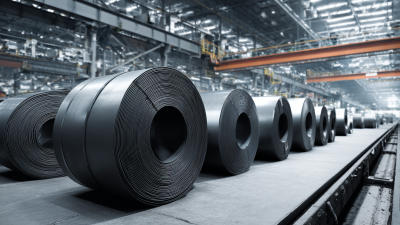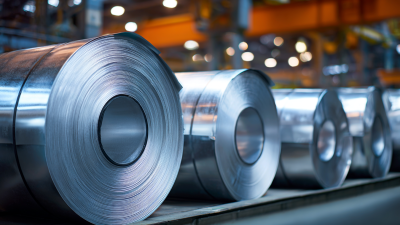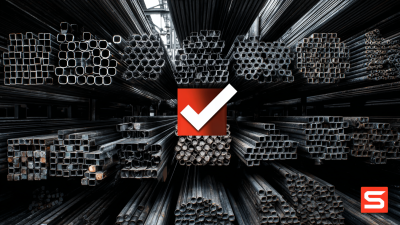In the realm of industrial infrastructure, the application of Hot Dip Pipe has gained significant traction, driven by its durability and resistance to corrosion. According to a recent report by the International Pipe Association, global consumption of galvanized steel pipes, which includes Hot Dip Pipe, is projected to reach over 12 million tons by 2025, reflecting an annual growth rate of 5% driven by the increasing demand in sectors such as construction and energy. As industries evolve, the need for reliable piping systems that can withstand harsh environmental conditions becomes paramount. This blog aims to explore the various applications of Hot Dip Pipe within industrial infrastructure, highlighting its advantages, market trends, and best practices for implementation, ultimately serving as the ultimate guide for professionals seeking to leverage this robust solution in their projects.

Hot dip galvanization is a crucial process that enhances the durability of pipes used in industrial infrastructure. By immersing steel pipes in molten zinc, this technique creates a robust protective layer that significantly extends the lifespan of the material. This zinc coating acts as a barrier against corrosive elements, making hot dip galvanized pipes particularly advantageous for applications in harsh environments, such as chemical plants, wastewater treatment facilities, and marine settings.
Beyond mere corrosion resistance, hot dip galvanization offers additional benefits that contribute to overall system performance. The process not only fortifies the pipes against rust but also ensures that maintenance costs are reduced over time. Furthermore, the adherence of the zinc layer is excellent, which means it withstands mechanical impacts and abrasions better than other protective methods. In light of these advantages, hot dip galvanized pipes emerge as a reliable choice for industries looking to invest in long-lasting, sustainable infrastructure solutions.
Hot dip pipes have become an integral part of water distribution systems due to their durability and corrosion resistance. According to the American Water Works Association (AWWA), approximately 40% of water distribution systems in the United States still use outdated materials, leading to inefficiencies and leaks. In contrast, hot dip galvanized pipes not only enhance the lifespan of infrastructure but also ensure clean water delivery, reducing the need for frequent replacements. This makes them a cost-effective solution for municipalities investing in modernization.

Tips: When selecting hot dip pipes for your projects, consider the expected water quality and the environmental factors that may affect the pipe’s performance. Always consult with industry standards and guidelines, such as those provided by the AWWA, to ensure compliance and longevity.
Moreover, the use of hot dip galvanized pipes can significantly decrease maintenance costs. A study by the National Association of Corrosion Engineers (NACE) indicates that corrosion-related issues can account for up to 30% of a utility's operational budget. By incorporating hot dip pipes, utilities can minimize these costs while providing high-quality service to their communities.
Tips: Conduct regular inspections and maintenance checks to identify potential corrosion points early on. Implementing a proactive approach will extend the life of your water distribution system and enhance overall efficiency.
Hot dip pipes play a crucial role in oil and gas infrastructure, providing a reliable solution to combat corrosion and extend the lifespan of essential pipelines. According to a report by the World Bank, corrosion can account for up to 3% of a country's GDP due to maintenance costs and lost productivity. This underscores the importance of utilizing hot dip galvanized (HDG) pipes, which offer significant resistance to corrosion and are particularly beneficial in harsh environmental conditions often found in oil and gas extraction sites.
When selecting hot dip pipes, it's essential to consider factors such as coating thickness, which should be between 85 to 180 microns for optimal performance in high-stress applications. Tips for ensuring durability include choosing pre-galvanized pipes for smaller applications and opting for larger diameter HDG pipes where heavy-duty protection is necessary. Moreover, regular inspections can help identify early signs of wear, allowing for timely maintenance that further enhances the longevity of the infrastructure.
In the context of sustainability, the use of hot dip pipes can significantly reduce the environmental impact of oil and gas operations. A study from the American Petroleum Institute highlights that properly protected pipelines can last over 50 years, minimizing the frequency of replacements and reducing hazardous spills. This fact accentuates the need for a thoughtful approach when integrating hot dip pipes into industrial systems, showcasing their dual benefits of increasing efficiency while being environmentally responsible.
| Application Area | Typical Pipe Diameter (inches) | Typical Wall Thickness (mm) | Temperature Range (°C) | Corrosion Resistance |
|---|---|---|---|---|
| Crude Oil Transport | 6 to 24 | 5 to 12 | -20 to 80 | High |
| Natural Gas Distribution | 4 to 30 | 3 to 10 | -40 to 60 | Medium |
| Refined Product Pipelines | 8 to 36 | 6 to 15 | -10 to 70 | Very High |
| Water Injection Lines | 8 to 20 | 5 to 12 | 10 to 50 | High |
| Heat Exchange Systems | 2 to 12 | 2 to 8 | 0 to 90 | Very High |
When considering pipe coating methods for industrial infrastructure, hot dip galvanization (HDG) stands out due to its robust protection against corrosion. This method involves immersing clean steel pipes in molten zinc, creating a metallurgical bond that coats the surface entirely. This seamless coverage is one of the primary advantages of HDG over alternatives like Zn-rich paints or powder coatings, which may leave gaps or inconsistencies leading to vulnerabilities. The durability of hot dip coatings makes them suitable for various conditions, including harsh environments where moisture and chemicals are prevalent.

On the other hand, methods such as electroplating and spray painting tend to have limited lifespans and require frequent maintenance. Electroplating provides a thinner layer of protection, which may wear away over time, especially in stressful industrial settings. Spray painting, while cost-effective, often needs to be reapplied more regularly than hot dip galvanization. Additionally, both methods can pose environmental constraints and health concerns due to volatile organic compounds. Therefore, while HDG is a more considerable upfront investment, its longevity and resistance to wear make it a preferred choice for extensive industrial applications.
When discussing the applications of hot dip pipes in industrial infrastructure, it is essential to consider the industry standards and regulations that govern their usage. Various organizations set these standards to ensure the safety, durability, and performance of piping systems across numerous industries, including oil and gas, water treatment, and construction. For example, the American Society for Testing and Materials (ASTM) provides guidelines on the quality and manufacturing processes of galvanized steel pipes, which are critical in hot dip applications to prevent corrosion and extend service life.
Additionally, compliance with local and international regulations, such as the American National Standards Institute (ANSI) and the Occupational Safety and Health Administration (OSHA) standards, is crucial for implementation. Organizations must adhere to these regulations to ensure that their infrastructure projects meet safety codes and environmental considerations. The adherence to standards not only promotes the longevity of the materials but also impacts the overall reliability and efficiency of industrial systems, ensuring that companies minimize downtime and maintenance costs associated with piping failures.









